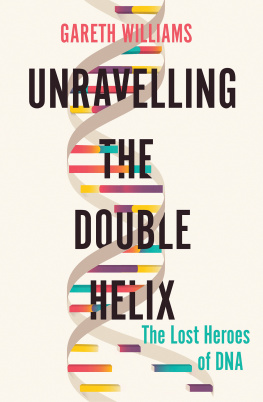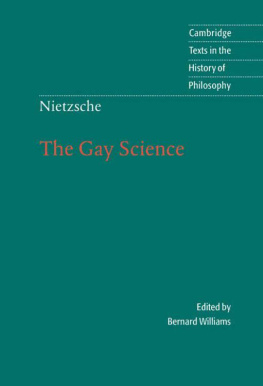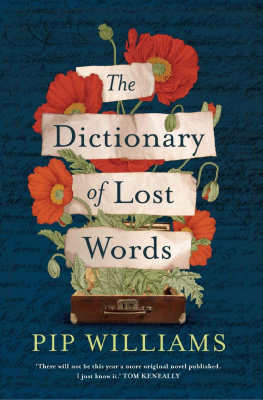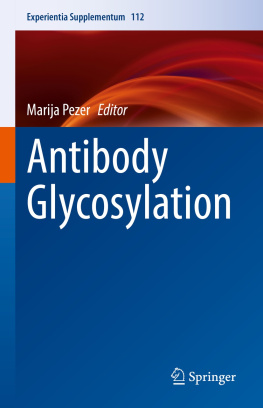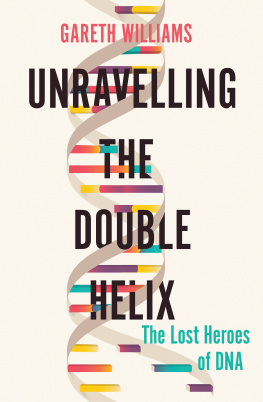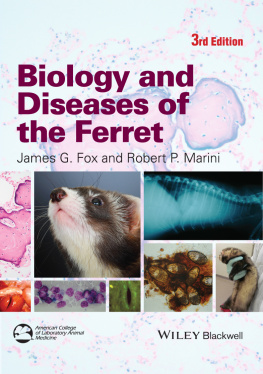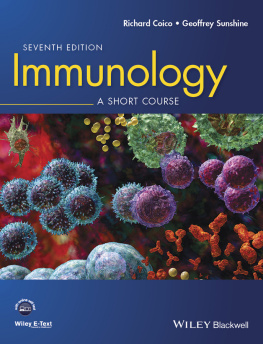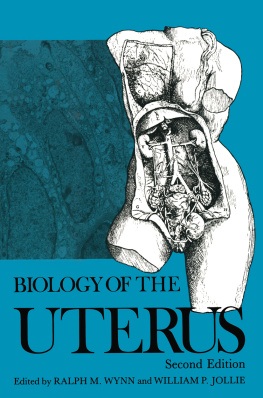Contents
Guide

Also by Gareth Williams
Angel of Death: The Story of Smallpox (2010)
Paralysed with Fear: The Story of Polio (2013)
A Monstrous Commotion: The Mysteries of Loch Ness (2015)
with Gema Frhbeck
Obesity: Science to Practice (2009)
with John Pickup
Textbook of Diabetes, editions 13 (19912002)
Handbook of Diabetes, editions 13 (19922002)
UNRAVELLING
THE DOUBLE HELIX
The Lost Heroes of DNA
GARETH WILLIAMS

U NRAVELLING THE D OUBLE H ELIX
Pegasus Books Ltd.
148 West 37th Street, 13th Floor
New York, NY 10018
Copyright 2019 by Gareth Williams
First Pegasus Books hardcover edition October 2019
All rights reserved. No part of this book may be reproduced in whole or in part without written permission from the publisher, except by reviewers who may quote brief excerpts in connection with a review in a newspaper, magazine, or electronic publication; nor may any part of this book be reproduced, stored in a retrieval system, or transmitted in any form or by any means electronic, mechanical, photocopying, recording, or other, without written permission from the publisher.
Library of Congress Cataloging-in-Publication Data is available
ISBN: 978-1-64313-215-0
ISBN: 978-1-64313-283-9 (ebook)
Distributed by W. W. Norton & Company, Inc.
With love and thanks to :
Caroline, Tim, Jo and Tessa
For putting up with me while I did another one
Dorothy Strangeways
For giving me the idea over tea in Hartington Grove
Gordon Doc Wright
For helping to keep me afloat in Cambridge, 19714
We all stand on each others shoulders.
Rosalind Franklin, March 1953
On hearing that James Watson and Francis Crick
had deduced the double helical structure of DNA
A science which hesitates to forget its founders is lost.
Alfred North Whitehead, September 1916
Address to the British Association for the Advancement of Science
CONTENTS
| 1833 | Robert Brown describes the nucleus in cells of orchids |
| 1866 | Gregor Mendel publishes Studies of plant hybridisation |
| 1868 | Friedrich Miescher discovers nuclein (DNA) in pus cells |
| 1878 | Albrecht Kossel isolates yeast nuclein (later shown to be RNA) |
| 1880 | Walther Flemming describes nuclear threads made of chromatin during cell division (mitosis) in the salamander |
| 1882 | Flemming suggests that chromatin and nuclein are identical |
| 1885 | Kossel extracts two bases, guanine and adenine, from thymus nuclein, followed by thymine (1893), cytosine (1894) and uracil (1900) |
| 1888 | Wilhelm Waldeyer renames Flemmings threads chromosomes |
| 1889 | Richard Altmann renames nuclein nucleic acid |
| 1900 | Mendels work is rediscovered by Carl Correns, Hugo de Vries and Erich von Tschermak |
| 1903 | Walter Sutton formulates the chromosome theory of inheritance |
| 1904 | William Bateson begins a pro-Mendel crusade and coins the word genetics |
| 1909 | Wilhelm Johannsen invents the words gene, genotype and phenotype Phoebus Levene identifies the sugar in yeast nucleic acid (RNA) as ribose |
| 1912 | Levene proposes that nucleic acids are a small tetranucleotide, containing one of each of the four bases Max von Laue takes the first X-ray photograph of a crystal |
| 1914 | Lawrence Bragg formulates Braggs Law of X-ray crystallography; with his father William, develops a new crystallography |
| 1915 | Thomas Hunt Morgan publishes The Mechanism of Mendelian Inheritance , based on mutations in the fruit fly |
| 1927 | Fred Griffith shows that dead pneumococci bacteria can transform (change the genetic characteristics of) live pneumococci, when injected into living mice |
| 1928 | Levene and Kossel both claim that genes are made of protein, not nucleic acid |
| 1929 | Levene identifies the sugar in thymus nucleic acid (DNA) as deoxyribose Martin Dawson, in Oswald Averys lab at the Rockefeller, confirms Griffiths finding of transformation of pneumococci, also in living mice |
| 1931 | Dawson and Richard Sia achieve transformation in vitro |
| 1932 | Lionel Alloway in Averys lab extracts the transforming principle responsible for transformation but cannot identify it chemically |
| 1937 | Torbjrn Caspersson deduces that DNA molecules are very long, thin cylinders, and much bigger than a tetranucleotide |
| 1938 | Florence Bell takes X-ray photographs of DNA; she and Bill Astbury suggest that the bases in the DNA molecule are stacked like a pile of pennies |
| 1940 | Colin MacLeod in Averys lab detects DNA in extracts of transforming principle but does not follow up the observation |
| 1941 | Alfred Mirsky extracts chromosin (DNA with associated protein) from cell nuclei |
| 1942 | Maclyn McCarty and Avery show that the transforming principle consists of DNA, with tiny amounts of contaminating protein |
| 1944 | Erwin Schrdinger suggests in his book What is Life? that genes are aperiodic crystals Avery, MacLeod and McCarty publish their landmark paper showing that DNA is the transforming principle and the genetic material in pneumococci Mirsky insists that protein, not DNA, mediates transformation and is the genetic material |
| 1947 | Rollin Hotchkiss shows that DNA contains unequal amounts of the four bases, thus ruling out the hypothetical tetranucleotide Andr Boivin proves that DNA also transforms other bacteria (E. coli ) Masson Gulland proposes that the DNA molecule is held together by hydrogen bonding between bases Gullands PhD student Michael Creeth proposes that DNA consists of two straight strands of DNA, linked by hydrogen bonding between bases on opposing strands |
| 1948 | Erwin Chargaff reports that amounts of adenine and thymine are equal, as are those of cytosine and guanine, in different sources of DNA Linus Pauling discovers the alpha-helix, crucial in shaping protein molecules |
| 1949 | Sven Furberg works out that the bases lie perpendicular to the backbone of DNA, and proposes a single-stranded, helical structure for DNA |
| 1950 | Ray Gosling at Kings takes an X-ray photograph showing a regular crystalline appearance of DNA (the A form) |
| 1951 | January : Rosalind Franklin joins the Biophysics Unit at Kings, to work on the X-ray structure of DNA May : Wilkins presents the crystalline DNA structure at a meeting in Naples and inspires Jim Watson to solve its structure Elwyn Beighton in Leeds takes an X-ray photograph that shows the helical features of DNA (B form). The photograph is ignored July : Wilkins presents DNA structures at a meeting in Cambridge and is told by Franklin to stop working on DNA Alec Stokes at Kings predicts the X-ray pattern of a helical molecule October : Jim Watson joins Francis Crick at the Cavendish Laboratory in Cambridge and persuades him to pursue the structure of DNA November : Wilkins meets Watson and Crick and tells them that the most likely structure contains three helical strands of DNA |

